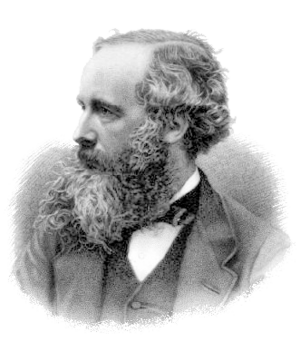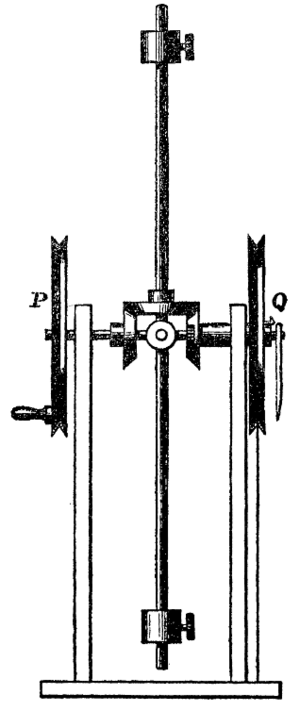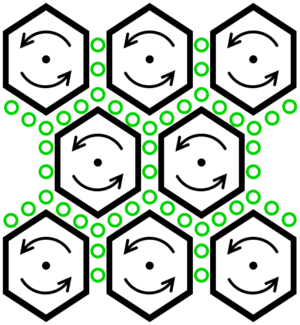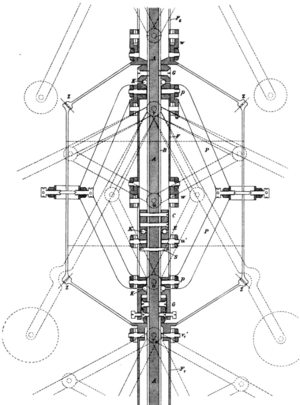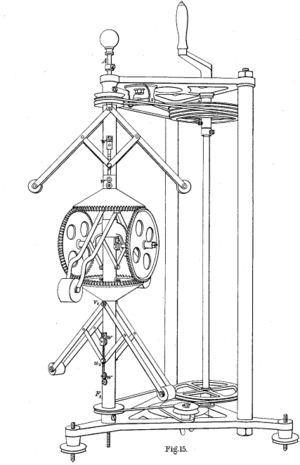History of Maxwell's equations facts for kids
Imagine a time when scientists knew a lot about electricity and magnetism, but these ideas were like puzzle pieces scattered everywhere. Scientists like Charles-Augustin de Coulomb discovered laws for static electricity, and André-Marie Ampère figured out how electric currents create forces. Michael Faraday showed how changing magnetism could create electricity, which is called electromagnetic induction. But all these discoveries weren't connected in one clear picture.
Then came James C. Maxwell, a brilliant scientist who worked at universities like University of Cambridge and King's College London. He was fascinated by Faraday's ideas about "lines of force," which were like invisible paths that electric and magnetic effects followed. Maxwell wanted to bring all these scattered ideas together.
From the 1850s to the 1870s, Maxwell published several important papers. He used clever models, like spinning "vortex tubes," to imagine how electromagnetic fields worked. He even thought of empty space (vacuum) as a stretchy, insulating material that could carry these forces. These ideas helped him create the first versions of what we now call Maxwell's equations.
One amazing thing Maxwell discovered was that the speed of electromagnetic waves, like light, could be calculated from constants related to electricity and magnetism. This was a huge clue! It suggested that light itself is an electromagnetic wave. In 1865, he published his most important paper, A Dynamical Theory of the Electromagnetic Field, where he put his theory into clear mathematical form. Later, in 1873, he summarized all his work in a book called A Treatise on Electricity and Magnetism.
Maxwell's equations were a huge step forward. They successfully joined the theories of light and electromagnetism, showing they were two parts of the same thing. This was one of the greatest "unifications" in the history of physics!
Maxwell even built a simple model using a flywheel to understand electromagnetism. Another scientist, Ludwig Boltzmann, made an even more detailed mechanical model called the "Bicykel" for his lectures.
Later, a scientist named Oliver Heaviside studied Maxwell's work. He used a special kind of math called vector calculus to simplify Maxwell's many equations (over 20!) into the four main ones that physicists use today. Maxwell's equations also inspired Albert Einstein when he developed his famous theory of special relativity.
The final proof that Maxwell's equations were correct came from experiments by Heinrich Hertz in the 1890s. He showed that electromagnetic waves really exist and travel at the speed of light, just as Maxwell predicted. After Hertz's experiments, scientists fully accepted Maxwell's amazing discoveries.
Contents
- How are Electricity, Magnetism, and Light Connected?
- What are "Maxwell's Equations" Today?
- Maxwell's Early Ideas: On Physical Lines of Force
- Maxwell's Later Work: A Dynamical Theory of the Electromagnetic Field
- Maxwell's Book: A Treatise on Electricity and Magnetism
- Maxwell's Equations and Relativity
- See also
How are Electricity, Magnetism, and Light Connected?
One of the most exciting parts of Maxwell's work was finding a deep connection between electricity, magnetism, and the speed of light. It can be shown with a modern equation:
On the left side, you have c, which is the speed of light. On the right side, you have numbers that come from measurements of electric and magnetic forces. Even though these numbers don't seem to have anything to do with speed, when you combine them in this way, they magically give you the speed of light!
This discovery started around 1855. Scientists Wilhelm Eduard Weber and Rudolf Kohlrausch found a special ratio between electric and magnetic units. They realized this ratio had the units of velocity. They measured it and found a value very close to the speed of light, which had been measured by other scientists like Hippolyte Fizeau and Léon Foucault.
However, Weber and Kohlrausch didn't realize the connection to light. It was Maxwell, in 1861, who looked at their results and put them together with his own ideas. He then understood that light is actually a form of electromagnetic radiation. This was a groundbreaking realization!
What are "Maxwell's Equations" Today?
The four main equations we call "Maxwell's equations" today weren't originally written exactly like that by Maxwell himself. His 1861 paper, On Physical Lines of Force, contained these ideas, but they were spread out and expressed differently.
It was Oliver Heaviside, along with Josiah Willard Gibbs and Heinrich Hertz, who, in 1884, gathered Maxwell's many equations into the four clear ones we use now. They used a simpler mathematical language called vector notation. These four equations were sometimes called the Hertz–Heaviside equations, but now everyone knows them as Maxwell's equations.
Maxwell's biggest contribution was adding a special term called the "displacement current" to Ampère's circuital law. This small but crucial addition allowed him to show that light is an electromagnetic wave. This idea was later proven true by Heinrich Hertz's experiments in 1887.
The famous physicist Richard Feynman once said that Maxwell's discovery of the laws of electromagnetism was probably the most important event of the 19th century, even more significant than big historical events like the American Civil War!
Albert Einstein also praised Maxwell's work. He wrote about Maxwell's excitement when his equations showed that electromagnetic fields spread as waves at the speed of light. Einstein said it took other physicists decades to fully understand how amazing Maxwell's discovery was.
Maxwell's Early Ideas: On Physical Lines of Force
Maxwell's 1861 paper, On Physical Lines of Force, contained the core ideas that would later become the four modern equations.
Here are some of the key ideas from that paper, explained simply:
- One equation (number 56 in his paper) is about how magnetic fields always form closed loops. You can't have a single "magnetic pole" by itself, like you can have a single electric charge. This is called Gauss's law for magnetism.
- Another equation (number 112) is a version of Ampère's circuital law, but with Maxwell's special addition: the displacement current. This addition was super important because it allowed Maxwell to predict electromagnetic waves.
- Equation 115 is Gauss's law, which describes how electric charges create electric fields.
- Equation 54 talks about electromagnetic induction, which is how changing magnetic fields create electric forces. This is often called 'Faraday's law'.
Maxwell also used the idea of a "sea of molecular vortices" to explain his concepts. He imagined tiny spinning whirlpools (vortices) everywhere. In this model, some magnetic quantities represented the "spin" of these vortices, while others represented the "density" of this vortex sea.
Maxwell's Later Work: A Dynamical Theory of the Electromagnetic Field
In 1865, Maxwell published "A dynamical theory of the electromagnetic field". In this paper, he clearly showed that light is an electromagnetic phenomenon. Sometimes people get confused because Maxwell's 1865 paper listed eight main equations, which, if you wrote them out for each direction (x, y, z), would become twenty equations!
These eight original equations from Maxwell's 1865 paper can be written in the modern vector form that Heaviside later used:
| [A] The law of total currents |  |
|---|---|
| [B] The equation of magnetic force |  |
| [C] Ampère's circuital law |  |
| [D] Electromotive force created by convection, induction, and by static electricity. (This is like the Lorentz force) |  |
| [E] The electric elasticity equation |  |
| [F] Ohm's law |  |
| [G] Gauss's law |  |
| [H] Equation of continuity | 
or
|
Maxwell used terms like "magnetic intensity" for H and "electric displacement" for D. He also used "electromotive force" for E, which is now called the electric field.
When Maxwell figured out the electromagnetic wave equation in this paper, he used equation [D] to explain electromagnetic induction. He showed that light is an electromagnetic wave.
Maxwell's Book: A Treatise on Electricity and Magnetism
In 1873, Maxwell published his big book, A Treatise on Electricity and Magnetism. This book summarized all his work. It included the eight equations from his 1865 paper, plus more. He used ideas like energy and potential to guide his theories.
In this book, Maxwell listed twelve general equations for the electromagnetic field. He even wrote them in a special mathematical form called "quaternion form," which was popular at the time, and also in a "vector form."
Here are some of the twelve equations from his book, showing how they relate to modern vector notation:
| Name | Quaternion Form | Vector Form |
|---|---|---|
| [A] Magnetic induction |  ; ;
|
 ; ;
|
| [B] Electromotive force |  |
 |
| [C] Mechanical force |  |
 |
| [D] Magnetization |  |
 |
| [E] Electric currents |  |
 |
| [F] Ohm's law |  |
 |
| [G] Electric displacement |  |
 |
| [H] Total current |  |
 |
| [I] When magnetization arises from magnetic induction |  |
 |
| [J] Electric volume density |  |
 |
| [K] Magnetic volume density |  |
 |
| [L] When magnetic force can be derived from a potential |  |
 |
Maxwell's goal was to show every known relationship in electromagnetism, even if it meant having more equations.
Maxwell's Equations and Relativity
Maxwell's equations were a huge inspiration for Albert Einstein's theory of special relativity. A key idea from Maxwell's work was that forces don't act instantly across distances. Instead, they travel through the electromagnetic field at the speed of light.
Maxwell's original ideas were based on the concept of a "luminiferous aether"—a mysterious substance that light was thought to travel through. Scientists believed the speed of light would depend on how fast you were moving through this aether. However, experiments designed to measure Earth's speed through the aether didn't find anything.
Scientists like Hendrik Lorentz and George Francis FitzGerald developed mathematical transformations (now called the Lorentz transformation) that showed Maxwell's equations worked the same way, no matter how fast an observer was moving.
Einstein took this idea further. He realized that the speed of light is always the same for everyone, no matter how they are moving. He used this idea, along with the Lorentz transformation, to create his theory of special relativity in 1905. Maxwell's equations were a key starting point for Einstein's revolutionary ideas about space and time.
Later, the general theory of relativity also connected with Maxwell's equations. For example, in the 1920s, scientists Theodor Kaluza and Oskar Klein showed that Maxwell's equations could be explained by adding an extra physical dimension to our universe. This idea of using extra dimensions to unify different forces is still an active area of research in physics today.
See also
- Classical electromagnetism and special relativity
- History of electromagnetic theory
- The Maxwellians


